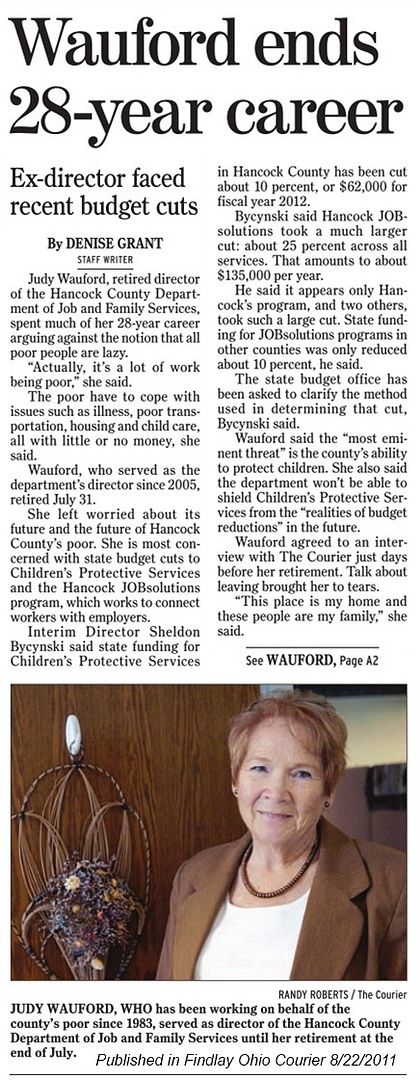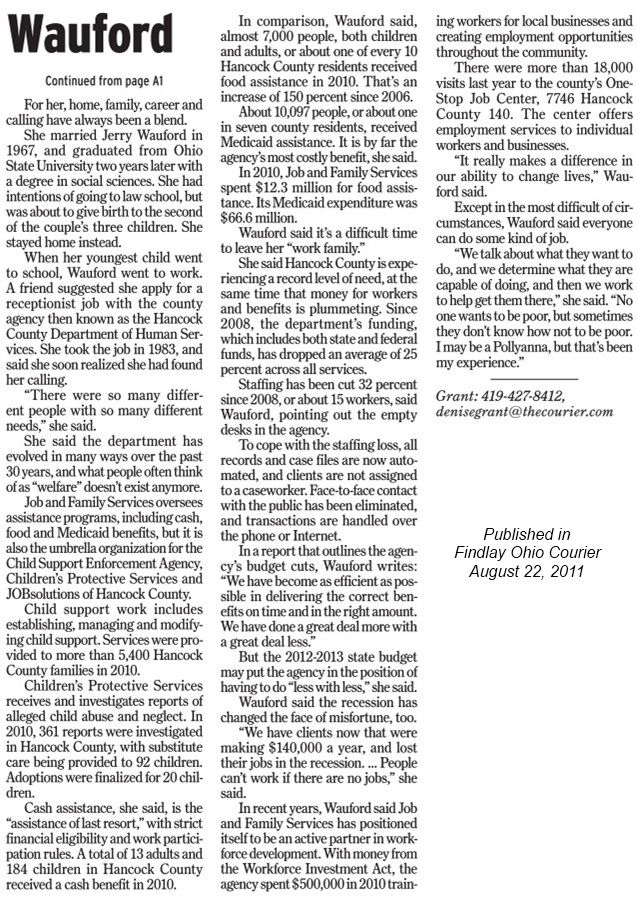
Just hearing the talking points makes me angry so forgive me if I sound angry. Someone will make a comment or bitch about “welfare queens” and about how these lazy poor people have wide-screen TVs and microwaves. If these comments come from friends and family, who should know better, it really drives me insane. Finally my hometown newspaper did me a solid and now I have some facts and figures to fight those biased FOX “news” talking points about poor people.
On Monday, August 22nd, the Findlay Ohio Courier had an article talking about the recent retirement of Judy Wauford, as director of the Hancock County Department of Job and Family Services (ODJFS). In Ohio, ODJFS handles the state and federal social safety net programs like unemployment, Medicaid, food stamps, and child support enforcement. The piece included some actual facts and data about the poor in Hancock county.
Hancock County Ohio is 44 miles south of Toledo in Northwest Ohio. The 2010 census put the county population at 74,782. In the 2000 census the racial demographics was 95.14% White, 1.11% Black or African American, and 3.07% Hispanic or Latino of any race. In politics it is as red as red can be and is represented by Rep. Jim Jordan (R-4), chair of the star chamber we know as the Republican Study Committee. The RSC sets the agenda for the GOP in blocking any compromise with President Obama on budget issues and it champions the Cut, Cap and Balance Act that the Senate tabled on July 22nd.
I loved the article because it included some concrete facts and figures from someone who has dealt with these issues in person:
“Actually, it’s a lot of work being poor,” she said.
The poor have to cope with issues such as illness, poor transportation, housing and child care, all with little or no money, she said.
She said Hancock County is experiencing a record level of need, at the same time that money for workers and benefits is plummeting. Since 2008, the department’s funding, which includes both state and federal funds, has dropped an average of 25 percent across all services.
Staffing has been cut 32 percent since 2008, or about 15 workers, said Wauford, pointing out the empty desks in the agency.
To cope with the staffing loss, all records and case files are now automated, and clients are not assigned to a caseworker. Face-to-face contact with the public has been eliminated, and transactions are handled over the phone or Internet.
In a report that outlines the agency’s budget cuts, Wauford writes: “We have become as efficient as possible in delivering the correct benefits on time and in the right amount. We have done a great deal more with a great deal less.”
But the 2012-2013 state budget may put the agency in the position of having to do “less with less,” she said.
Cash assistance, she said, is the “assistance of last resort,” with strict financial eligibility and work participation rules. A total of 13 adults and 184 children in Hancock County received a cash benefit in 2010.
In comparison, Wauford said, almost 7,000 people, both children and adults, or about one of every 10 Hancock County residents received food assistance in 2010. That’s an increase of 150 percent since 2006.
About 10,097 people, or about one in seven county residents, received Medicaid assistance. It is by far the agency’s most costly benefit, she said.
In 2010, Job and Family Services spent $12.3 million for food assistance. Its Medicaid expenditure was $66.6 million.
This is a county that is 95% white, is not a large urban area, and usually does better than the average on unemployment rates. In June 2011, Hancock county ranked 73rd out of 88 counties with an unemployment rate of 8.4% (Pike County had the highest at 15.4%).
This hits close to home since me and my family have been on public assistance several times over the years. When those false FOX talking points start flying it takes all my strength not to punch biased conservatives in the mouth.
The other day a family member was all excited when Florida started drug tests for those getting assistance. Friends of hers chimed in that “it was about time…” and bringing up those false “welfare queen” talking points.
I responded with some of the same points written in the Wauford article about how much work it is to be poor, the rules are so strict, and how “welfare” hasn’t really existed since the Personal Responsibility and Work Opportunity Act was made a law in 1996.
My relative defended herself and her friend’s views and ended the argument with the petty “We will just have to agree to disagree”.
Well not really because that same family member was on welfare nearly 30 years ago when she and her husband was just starting out when they got married. Neither one had a job and their eldest child was just born. Those WIC coupons, food stamps, energy assistance, and cash assistance kept them from being hungry and homeless. Government programs also helped her pay for schooling that led to her career as a Nurse.
People who forget where they come from are the worst fools I know.
I now have some actual facts and figures to bolster my argument. Maybe I need to pass it on to my relative and elected officials who think they know better like Rep. Jim Jordan.
*Notes*
Originally posted on Daily Kos. It made the Rec List and was in the Community Spotlight on August 22nd.
The clipping
In case the link to the Courier article stops working since they move items to an archive that requires money to access, here are images of the article as it appeared in the print edition on August 22nd — dlb



